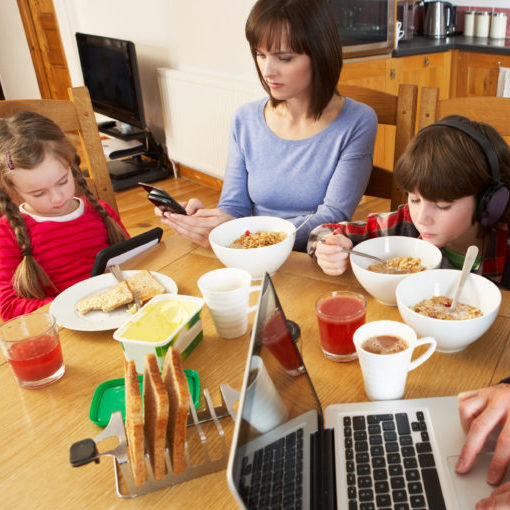
Today’s kids are totally connected — to surfing, scrolling, snapping, gaming and ‘gramming. According to new Pew Reseach, 95% of teens have access to a smartphone and 45% say they are online ‘almost constantly.’ Stats like those give way to rising concern over the addictiveness of constantly checking for social media updates, watching videos and playing games. Some studies tie extended screen time to distraction in classrooms, symptoms of ADHA, sleep deprivation and depression.
But what we’ve learned as digital parenting evolves is that the challenge is less about how much screen time our kids have and more about the quality of time they spend online. Research also shows that when you actively engage with people and issues you care about – it can have a positive impact on your well-being.
HOW CAN PARENTS CREATE HEALTHY TECH HABITS?
It starts young and it’s a daily conversation – it fits right in with eating well, brushing teeth, getting enough sleep, exercise or even later on – learning how to drive a car. You don’t just throw your kids into it all and expect them to thrive.
Model good behavior yourself. No phones at mealtimes. Put screens away two hours before bedtime and charge them all up in one central family charging station overnight – no screens in bedrooms. Why? Because we know it messes with your sleep. It’s that simple.
This isn’t about being afraid or making arbitrary – no tech at all rules – in fact, that’s the one thing we’ve learned really does not work. You tell a teen – NO social media – and they’ll get it at their friends’ house – and if or when they do have trouble with it – they feel like they can’t come to talk with you about it.
Instagram and Facebook also say you have to be 13 to be on their platforms. Follow those rules. Encourage your kids not to use fake birthdays to go on earlier. Find out about how kids brains develop and explain it to them – talk with them about it.
The part of the brain responsible for things such as planning, decision-making and impulse control (the frontal cortex) grows slowly over the teen years and is not fully developed until our 20s. Screen time releases the chemical dopamine in the reward centers of the brain, and there is no other time in life when you’re as susceptible to that pleasure-producing chemical than in adolescence.
The worst thing a parent can do is hand over a smartphone and hope for the best. But parents often feel like trying to set limits is pointless, that the cat is out of the bag, tech is everywhere. I hear all kinds of excuses. But kids’ brains aren’t wired to self-regulate. They can’t do it without you, and they shouldn’t have to. Supervise them safely and wisely and allow them to really learn and grow into good digital citizens.
NEW TOOLS TO HELP US HELP OURSELVES
As I wrote about extensively August 1st, Facebook and Instagram just released a new set of tools to manage your time on their apps. Over the next couple of weeks, you’ll see the new tools – including an activity dashboard that shows you how much time you spend on the apps, a way to set a daily reminder not to exceed a certain amount of time, and a new way to limit notifications
To access the tools on Instagram, go to your Settings then tap “Your Activity,” (For Facebook, start at your settings and then go to “Your Time on Facebook.”) From there, you’ll see a dashboard showing your average time for that app. Below that, there will be a bar chart broken down by day of the week to show you the individual counts for each day. Have a look at those numbers, consider how you feel about them, and then set a goal if you think you need to cut back. Right under your time tally is the option to “Manage Your Time.” You tap in how much time per day you’d like to spend on the apps. If you hit your limit, you’ll get a pop-up message saying so.
IS IT POSSIBLE TO BE A DIGITALLY SAVVY WELL-WIRED FAMILY?
It’s totally possible. I’m doing it with my 17-year old now. Nothing really beats having a good, open, honest, solid relationship with your kids. What I’ve found with her and other teens – most of what they’re doing on social is really positive – they’re connecting with people and issues they’re passionate about. Talk with them about who they’re following on Instagram and why.
You put the time and work in early – teach them wired-wellness – and you’ll see huge dividends later.
Whether you’re a grown-up or a teen, the time you spend on Facebook or Instagram should be intentional, positive and inspiring. The hope here is these tools give people more control over the time they spend on social media and foster conversations between parents and teens about the online habits that healthiest for them.
Digital Parenting Resources:
Grown and Flown Parents Facebook Group: Grown and Flown is the destination for parents teens and college age kids to find information, insight, and support for this season of life. Join us…because parenting never ends.
